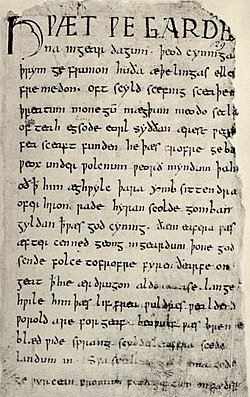English classics
 From Wikiversity - Reading time: 3 min
From Wikiversity - Reading time: 3 min

Beowulf
[edit | edit source]Beowulf is the earliest epic poem written in the English language. The poem was composed in approximately A.D 400, although not physically written down until the mid to late 800s.
As an epic poem Beowulf shares many similarities with Homer's Iliad such as the idea of a hero fighting against forces that threaten his world order, and employing elevated language to tell the story in a serious tone that underscores the importance of the hero's struggles. In literary terms, Beowulf is representative of cultural pressures which faced the Germanic and Norse world as Christianity gained a foothold in previously pagan areas of Western Europe. In contrast to the common medieval theme of a Christian protagonist, the reader is faced with a medieval European hero struggling against Christianity in defence of his pagan belief systems.
When reading the poem, it is often easier to focus on less than one hundred lines at a time in order to better understand the language and parse it apart for meaning. What will be particularly difficult when reading Beowulf is the fact that although written in verse form, the sentences will often be fifteen, even twenty lines long, and one must read an entire sentence in order to make sense of what the poet is saying.
Beowulf: Lesson One
[edit | edit source]Aim: What is a legendary hero?
Objective: At the end of this lesson you will be able to identify the elements of a legendary (or epic) hero and apply it to characters in any literary work you read. In addition you will be able to identify Anglo-Saxon literary elements used in the poem.
Elements of a Legendary Hero
- The hero battles forces that threaten the order of his world as he knows it.
- The story is told in a serious manner, often using formal, elevated language.
A legendary hero is a larger than life character whose accomplishments are celebrated by his people as being ideal for the society in which he comes from. A legendary hero will often have greater than normal abilities that are upheld as values of his culture.
In Beowulf, the character completes great feats of strength, boasts endlessly of his past deeds, and seems to ooze loyalty, honor, and bravery from his very pores. All of which are traits greatly valued by the Anglo-Saxons at the time of the poem's composition.
Anglo-Saxon Literary Elements: In addition, because Beowulf is an epic poem of the Anglo-Saxon people, it will use two specific Literary Elements found in Anglo-Saxon literature known as Kenning and Caesura.
- In its simplest form, a Kenning can be defined as a multi-word descriptive nick-name for a noun. For example "whale's-road" to describe the ocean.
Below is the poet's introduction of the character Beowulf, in italics are two examples of a kenning being used to describe the character of Beowulf.
But a warrior of Hygelac's
heard of Grendel's doings;
he was the strongest of men
alive in that day,
mighty and noble.
That man called for a ship,
said he would cross the ocean
and help the king who needed help.
Wise men urged him
to that adventure
though he was dear to them.
They examined omens
and whetted him on.
So the good Geat chosethe bravest warriors,
fourteen of them,
and that crafty sailor
led them to the land's brim,
to the ship.[1]
Beowulf: Lesson Two
[edit | edit source]Aim: How are Anglo-Saxon belief systems revealed in Beowulf?
Objective:
References
[edit | edit source]- ↑ The Adventures of Beowulf an Adaptation from the Old English by Dr. David Breeden
 KSF
KSF